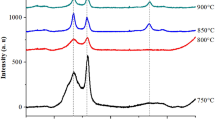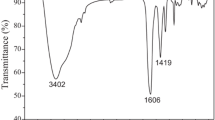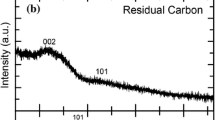Abstract
China rose petal was used as robust biotemplate for the facile fabrication of novel ceria nanosheet with a thickness of about 7 nm via a continuous infiltration process. The presence of well-resolved peaks ([111], [200], [220], and [311]) for the products revealed the formation of the fluorite-structured CeO2. The detailed characterization by field-emission scanning electron microscope (FESEM), field-emission transmission electron microscope (FETEM), and atomic force microscopy (AFM) exhibited the biomorphic structure of polycrystalline ceria film with the nanoparticle size of ca. 6.98 nm. Based on the surface chemistry and biochemistry processes, a possible mechanism for the formation of CeO2 nanosheets is proposed. Furthermore, nitrogen adsorption–desorption measurement and photoluminescence spectrum (PL) were employed to characterize the samples. The ceria nanosheet showed the existence of mesopores (pores 2–4 nm diameter) on its surface and a broad emission ranging from 350 to 500 nm in photoluminescence spectrum. X-ray photoelectron spectroscopy analysis (XPS) confirmed that the mesoporous nanosheets possessed more surface vacancies than the bulk CeO2; hence these hierarchical CeO2 layers appear to be potential candidates for catalytic applications.










Similar content being viewed by others
Abbreviations
- 2D:
-
Two-dimensional
- 3D:
-
Three-dimensional
- XRD:
-
Powder X-ray diffraction
- AFM:
-
Atomic force microscopy
- FESEM:
-
Field-emission scanning electron microscope
- TEM:
-
Transmission electron microscope
- FETEM:
-
Field-emission transmission electron microscope
- PL:
-
Photoluminescence spectrum
- XPS:
-
X-ray photoelectron spectroscopy
References
Dai GH, Nicole M, Andary C, Martinez C, Bresson E, Boher B, Daniel JF, Geiger JP (1996) Flavonoids accumulate in cell walls, middle lamellae and callose-rich papillae during an incompatible interaction between Xanthomonas campestris pv. malvacearum and cotton. Physiol Mol Plant Pathol 49(5):285–306
Davies LM, Harris PJ, Newman RH (2002) Molecular ordering of cellulose after extraction of polysaccharides from primary cell walls of Arabidopsis thaliana: a solid-state CP/MAS 13C NMR study. Carbohyd Res 337(7):587–593
Dong Q, Su H, Zhang D, Zhu N, Guo X (2006) Biotemplate-directed assembly of porous SnO2 nanoparticles into tubular hierarchical structures. Scr Mater 55(9):799–802
Dupin J-C, Gonbeau D, Vinatier P, Levasseur A (2000) Systematic XPS studies of metal oxides, hydroxides and peroxides. Phys Chem Chem Phys 2(6):1319–1324
Guo M, Lu J, Wu Y, Wang Y, Luo M (2011) UV and visible Raman studies of oxygen vacancies in rare-earth-doped ceria. Langmuir 27(7):3872–3877
Ho C, Yu JC, Kwong T, Mak AC, Lai S (2005) Morphology-controllable synthesis of mesoporous CeO2 nano- and microstructures. Chem Mater 17(17):4514–4522
Hussein MZ, Azmin WHWN, Mustafa M, Yahaya AH (2009) Bacillus cereus as a biotemplating agent for the synthesis of zinc oxide with raspberry- and plate-like structures. J Inorg Biochem 103(8):1145–1150
Ji P, Zhang J, Chen F, Anpo M (2008) Ordered mesoporous CeO2 synthesized by nanocasting from cubic Ia3d mesoporous MCM-48 silica: formation, characterization and photocatalytic activity. J Phys Chem C 112(46):17809–17813
Koelling DD, Boring AM, Wood JH (1983) The electronic structure of CeO2 and PrO2. Solid State Commun 47(4):227–232
Lagaert S, Beliën T, Volckaert G (2009) Plant cell walls: protecting the barrier from degradation by microbial enzymes. Semin Cell Dev Biol 20(9):1064–1073
Liu X, Zhou K, Wang L, Wang B, Li Y (2009) Oxygen vacancy clusters promoting reducibility and activity of ceria nanorods. J Am Chem Soc 131(9):3140–3141
Lu X-h, Huang X, Xie S-l, Zheng D-z, Liu Z-q, Liang C-l, Tong Y-X (2010) Facile electrochemical synthesis of single crystalline CeO2 octahedrons and their optical properties. Langmuir 26(10):7569–7573
Masson S, Holliman P, Kalaji M, Kluson P (2009) The production of nanoparticulate ceria using reverse micelle sol gel techniques. J Mater Chem 19(21):3517–3522
Noronha FB, Fendley EC, Soares RR, Alvarez WE, Resasco DE (2001) Correlation between catalytic activity and support reducibility in the CO2 reforming of methane over Pt/CexZr1-xO2 catalysts. Chem Eng J 82(1–3):21–31
Osada M, Ebina Y, Takada K, Sasaki T (2006) Gigantic magneto-optical effects in multilayer assemblies of two-dimensional titania nanosheets. Adv Mater 18(3):295–299
Seo J-w, Jun Y-w, Park S-w, Nah H, Moon T, Park B, Kim J-G, Kim Youn J, Cheon J (2007) Two-dimensional nanosheet crystals. Angew Chem Int Ed 46(46):8828–8831
Shyu JZ, Weber WH, Gandhi HS (1988) Surface characterization of alumina-supported ceria. J Phys Chem 92(17):4964–4970
Sugiyama Y, Okamoto H, Mitsuoka T, Morikawa T, Nakanishi K, Ohta T, Nakano H (2010) Synthesis and optical properties of monolayer organosilicon nanosheets. J Am Chem Soc 132(17):5946–5947
Sujana MG, Chattopadyay KK, Anand S (2008) Characterization and optical properties of nano-ceria synthesized by surfactant-mediated precipitation technique in mixed solvent system. Appl Surf Sci 254(22):7405–7409
Sun C, Li H, Chen L (2007) Study of flowerlike CeO2 microspheres used as catalyst supports for CO oxidation reaction. J Phys Chem Solids 68(9):1785–1790
Sun Z, Zhang H, An G, Yang G, Liu Z (2010) Supercritical CO2-facilitating large-scale synthesis of CeO2 nanowires and their application for solvent-free selective hydrogenation of nitroarenes. J Mater Chem 20(10):1947–1952
Tana, Zhang M, Li J, Li H, Li Y, Shen W (2009) Morphology-dependent redox and catalytic properties of CeO2 nanostructures: nanowires, nanorods and nanoparticles. Catal Today 148(1–2):179–183
Terrones M (2009) Materials science: nanotubes unzipped. Nature 458(7240):845–846
Yang Z, Niu Z, Lu Y, Hu Z, Han CC (2003) Templated synthesis of inorganic hollow spheres with a tunable cavity size onto core-shell gel particles. Angew Chem Int Ed 42(17):1943–1945
Yang Z, Wei J, Yang H, Liu L, Liang H, Yang Y (2010) Mesoporous CeO2 hollow spheres prepared by Ostwald ripening and their environmental applications. Eur J Inorg Chem 2010(21):3354–3359
Yuan Q, Duan H–H, Li L–L, Sun L-D, Zhang Y-W, Yan C-H (2009) Controlled synthesis and assembly of ceria-based nanomaterials. J Colloid Interface Sci 335(2):151–167
Zhang F, Wang P, Koberstein J, Khalid S, Chan S-W (2004) Cerium oxidation state in ceria nanoparticles studied with X-ray photoelectron spectroscopy and absorption near edge spectroscopy. Surf Sci 563(1–3):74–82
Zhou K, Wang X, Sun X, Peng Q, Li Y (2005) Enhanced catalytic activity of ceria nanorods from well-defined reactive crystal planes. J Catal 229(1):206–212
Zhou H, Fan T, Zhang D (2007) Hydrothermal synthesis of ZnO hollow spheres using spherobacterium as biotemplates. Micropor Mesopor Mat 100(1–3):322–327
Acknowledgments
The authors would like to thank Shanghai Institute of Ceramics, Chinese Academy of Sciences for providing FETEM and FESEM facilities. This study is supported by National Natural Science Foundation of China (21071107) and Provincial Science Foundation of Jiangsu (BK2008541).
Author information
Authors and Affiliations
Corresponding author
Rights and permissions
About this article
Cite this article
Qian, J., Chen, F., Zhao, X. et al. China rose petal as biotemplate to produce two-dimensional ceria nanosheets. J Nanopart Res 13, 7149–7158 (2011). https://doi.org/10.1007/s11051-011-0626-2
Received:
Accepted:
Published:
Issue Date:
DOI: https://doi.org/10.1007/s11051-011-0626-2




